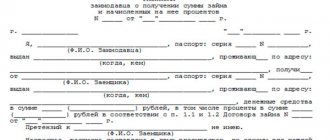Home / Real estate / Purchasing real estate / Buying an apartment
Back
Published: 12/19/2017
Reading time: 6 min
0
106
The purchase of real estate using borrowed funds is currently widespread in the Russian Federation, since a large number of people want to purchase housing for themselves, but do not always have all the necessary amount to make such a purchase.
- What is collateral and when is it used?
- Procedure for registering a pledge
- Registration of the contract
As a guarantee of the return of borrowed funds, the bank requires the provision of collateral, the use of which is drawn up in a special agreement.
Who can draw up a loan agreement secured by real estate?
All individuals who have reached the age of 18 and have legal capacity can enter into a real estate pledge agreement to secure a loan. However, it is not necessary to have Russian citizenship. Foreign citizens and stateless persons can also participate in the transaction.
Any real estate object can be used as collateral: apartment, house, land, garage, room, commercial premises, unfinished construction, etc. The lender has the right to establish requirements for the condition of the collateral. For example, he may refuse to provide money if dilapidated housing is offered as collateral.
Real estate can only be pledged by the owner. Ownership must be documented. This means that if a person lives in an apartment on the basis of a social tenancy or rental agreement, he cannot use it as security for receiving funds.
Concept
Many Russian citizens confuse 3 concepts with each other:
- pledge;
- deposit;
- prepaid expense.
But when concluding transactions, they have significant differences between themselves, which lead to different legal consequences. So, the main distinctive features of the pledge are its non-monetary form. This specific additional obligation guarantees the fulfillment of the main one. And in case of non-fulfillment, the title to the collateral is assigned.
The deposit can be given in the form of:
- movable property;
- immovable.
Title documents for a car or other property can be provided as movable property. And real estate is called a mortgage. This type of pledge is formalized as an encumbrance; this transaction must be registered by Rosreestr.
Therefore, the main feature of a pledge is its proprietary nature. The right of pledge can be transferred by inheritance and on the basis of other alienation agreements.
When registering a pledge, movable property is transferred to the pledgee only for storage. He has no right to use it. When real estate is pledged, it remains with the pledgor with the right to use and own it.
Documents for registration
To draw up a pledge agreement, you must have the civil passports of the parties. The text of the agreement must indicate the details of the pledge holder and the pledgor.
A loan agreement will also be required for registration. Information about this document and the essence of the transaction must also be specified in the real estate pledge agreement.
In addition, it is necessary to provide documents confirming ownership of the property, as well as technical documentation of the property. The contract will need to specify the location address, area and other data that helps identify the object.
The collateral is subject to assessment. To carry out this activity, you will need to contact an appraisal company or an independent appraiser. The specialist will carry out the necessary work and prepare a report that will contain the current market value.
Legal actions with real estate are subject to state registration. Without going through this procedure, the pledge agreement will not enter into legal force and will be considered unconcluded.
Registration is carried out with the authorities of Rosreestr or MFC. To do this, you will need to prepare the following documents:
- an application from both parties (if the agreement was notarized, an application from one party to the transaction will be required);
- receipt of payment of state duty;
- the pledge agreement in three copies – one for each party and for Rosreestr;
- a document providing the basis for the emergence of ownership rights - a deed of gift, a purchase and sale agreement, a certificate of accession to inheritance rights, etc.;
- technical documents from BTI;
- an extract from the house register or the house register itself, if the collateral is a private house;
- act of redevelopment, if it was carried out;
- consent of the husband/wife to execute the transaction, certified by a notary;
- marriage certificate or divorce certificate;
- a certificate stating that at the time of purchasing the property the mortgagor was not married (issued by a notary).
If a representative acts on behalf of the owner, it is necessary to provide a power of attorney certified by a notary.
Instructions
Let's look at a step-by-step guide to concluding a contract:
- Step 1. When indicating the property you are mortgaging, you are required to indicate its characteristics. Without a description, the contract simply will not gain its force.
- Step 2. Before drawing up a collateral agreement, the collateral must be assessed. The Civil Code does not contain specific regulations on how the value of the collateral is determined. Often, for this purpose, the services of experts are resorted to, but, in essence, there is an agreement between the parties.
- Step 3. Not all cases require a visit to a notary. But if you are mortgaging the following objects, the agreement must be certified: mortgage, real estate, movable property or rights to it.
- Step 4. The real estate pledge agreement must undergo state registration. This can be done by writing an application to the justice institution for registration of rights to real estate. There is a corresponding law dated July 21, 1997 N 122-FZ.
How to draw up a real estate pledge agreement
When securing a loan with real estate, it is necessary to draw up a collateral agreement. This is an additional document that is required to be drawn up. You cannot combine both documents into one.
Dear readers! We cover standard methods for solving legal problems, but your case may be unique. We will help you find a solution to your problem for free
— simply call our legal consultant at:
+7 (499) 391-70-75 (Moscow)
+7 (812) 305-27-75 (Saint Petersburg)
8 (800) 550-97-45 (free call within Russia)
It's fast and free ! You can also quickly get an answer through the consultant form on the website.
Collateral is an additional obligation to the loan agreement. If the loan is found to be invalid, the pledge is canceled.
There is no standard form of agreement established by law. When drawing up, it is necessary to focus on the specifics of the transaction and the details of a specific situation. The loan agreement stipulates that “in order to ensure proper fulfillment of obligations to repay the loan amount within the prescribed period, the borrower provides the following property as collateral: (identification information about the property).”
It is further stated that the pledge agreement is an annex to the loan agreement. Accordingly, the real estate pledge agreement is drawn up in the second place.
The pledge agreement is drawn up in simple written form. In some cases, notarization may be required. The text of the document must contain:
- date and place of compilation;
- Full names of the parties, their passport details and address of permanent residence;
- information about the main agreement (type, details);
- description of the collateral – type, identification data, estimated value;
- rights and obligations of the parties;
- the procedure for replacing the collateral with other property;
- the amount of debt that is secured by the collateral;
- liability of the parties in case of violation of the terms;
- procedure for storing collateral;
- contract time;
- procedure for making adjustments and termination;
- additional conditions - whether the mortgagor can dispose of the property, whether the approval of the borrower is needed to replace the collateral, etc.;
- signatures of the parties.
The text of the document is written in business legal language. It is better to use the help of a specialist for these purposes.
Procedure for compilation
As already indicated, the contract is drawn up in writing.
It includes:
- participants in the transaction;
- information about the requirement that must be provided: type of main. agreement, its details and parties;
- the subject of the pledge, its data and value;
- rights and obligations of signatories;
- the extent to which the collateral secures the claim;
- responsibility of signatories;
- time frames, procedure for adjusting and canceling a transaction;
- other conditions;
- details of the signatories.
Mandatory terms of the pledge agreement
Without specifying the mandatory conditions, the contract is considered invalid. These conditions are:
- name of the document indicating the date and place of the action;
- passport details of the parties;
- description of the subject of the contract;
- duration of the agreement;
- link to the loan agreement (document details);
- duties of the parties;
- settlement of disputes;
- signatures of the parties.
It is important to note that the subject of collateral may not be any property. If real estate is provided as collateral, the provision of which as security is impossible by law, the contract will also be invalidated.
Such property is:
- withdrawn from circulation;
- emergency or dilapidated;
- not owned by the pledgor;
- burdened with arrest or other obligation.
In other cases, there are no obstacles to processing documents.
Subject and parties of the agreement
The most essential condition of the loan agreement is the subject of the loan agreement, which is real estate transferred by the mortgagor as security for the obligation assumed.
At the same time, according to paragraph 1 of Art. 336 of the Civil Code of the Russian Federation, certain types of property cannot act as collateral. The parties to the loan agreement are the pledgee and the pledgor. At the same time, not only the borrower, but also a third party can act as a mortgagor (Clause 1, Article 335 of the Civil Code of the Russian Federation).
In addition, the mortgagor is obliged to confirm that the property being transferred belongs to him.
The mortgagee is the party who accepts the property to secure the loan.
The parties to the contract can be both individuals and legal entities. faces.
Note. Parties to the DZ cannot be incapacitated persons or citizens with limited abilities.
Main elements of a pledge agreement
The form of the work permit is always written.
At the same time, certification of the document by a notary is not necessary. The Civil Code of the Russian Federation does not define a single template for the RD, however, it provides for a number of essential requirements for the form and content of the document. The main elements of remote sensing include:
Subject of the agreement.
This element presupposes the name of the real estate being pledged, its parameters and other features that ensure its identification. The property rights of the mortgagor are also noted here, with the display of title materials for the immovable mortgaged property.
Contract time.
This item reflects the period for fulfilling the accepted obligation secured by the mortgaged real estate. Here it is required to display the specific moment of the beginning of the validity of the contract and the moment of the end of full fulfillment of the accepted obligations.
The procedure for transferring the collateral.
This shows how the mortgaged property is transferred to the mortgagee. When transferring mortgaged real estate to the mortgagee, a bilateral acceptance deed is required.
Storing the collateral
The parties need to decide who will hold the collateral until the debt is paid. In accordance with Art. 338 of the Civil Code of the Russian Federation, the object remains with the pledgor, unless a different procedure was provided for by the agreement. In some cases, it is permitted to transfer property for storage to third parties.
Information about the storage procedure is also written in the text of the document. If this clause was not provided for in the contract, then by default the property remains with the borrower.
If any difficulties or disputes arise, please seek legal advice. You can get free legal assistance on our website. in a special window.
Now you know how a real estate pledge agreement is drawn up to secure a loan agreement. It is recommended that you consult a professional lawyer to draft the document. This will help avoid problems in the future.
Pledge agreement for the purchase of an apartment, sample
In order to leave a deposit when purchasing real estate, in particular an apartment, you need to correctly draw up an agreement that will spell out all the nuances regarding the fulfillment of obligations to return the deposit back.
Common examples when the need for collateral arises:
- If the former owner has not yet checked out of the apartment at the time of the purchase and sale transaction. The pledge guarantees the fulfillment of this obligation.
- If there are some things temporarily left in the apartment for sale. The pledge agreement ensures the safety of this property, or monetary compensation in the event of damage or loss of these things.
- If the previous owner of the apartment has debts to pay for housing and communal services, then he is obliged to pay them off within the agreed period. Otherwise, the amount of the debt will be demanded in court in accordance with the conditions specified in the agreement.
Before concluding a pledge agreement when selling an apartment, it is worth reviewing a sample of it.
Sum
If the deposit when purchasing an apartment is determined in monetary terms, it can be real or conditional.
When the parties come to an agreement on a conditional deposit, this is spelled out in detail in the contract. For example, if the issue is to pay for housing and communal services, then after the sale of the apartment the former owner is obliged to liquidate all debts. Otherwise, the new owner can go to court and pay all legal costs at the expense of the previous owner in accordance with the terms of the agreement.
In any case, the amount of the deposit when purchasing an apartment is determined by the parties to the agreement depending on the conditions for securing the pledge obligations.
Registration procedure
The success of the entire transaction will depend on how competently the purchase and sale agreement and the deposit agreement are drawn up. Unfortunately, not many Russian citizens know how to document a pledge correctly.
Advances and deposits can be made in regular written form. These documents do not require notarization. But the pledge is issued with the obligatory participation of a notary. The pledge agreement must clearly state the rights and obligations of the parties, as well as their responsibilities for failure to fulfill their obligations.
Main points
The pledge agreement, like any other document, must contain basic mandatory information that provides legal force to this document. Mandatory provisions:
- There must be personal and passport information about the parties to the agreement. There must be a clear division of who is who. One must be the pledgor, the other the pledgee.
- Information about the main obligation and the document that is a written confirmation of this agreement.
- Collateral information. An accurate, complete description of all significant characteristics of the property being pledged must be indicated.
- The agreement must include a provision on the possibility or prohibition of replacing the collateral property with another property during the term of the agreement.
- Obligations and rights of both parties. In these paragraphs it is very important to write down all the main points that are acceptable under various life circumstances. The terms of the agreement must not violate the fundamental rights of the parties to the transaction provided for by the Civil Code and other legal acts.
- The document must contain a financial assessment of the value of the collateral property and to what extent the price of the collateral covers the claims.
- The contract must contain a list of possible risks borne by both parties to the transaction, as well as the responsibilities of each party.
- Like any other agreement, this document must have a certain validity period, conditions for its extension, early termination, and conditions for changing it.
- Details of the parties to the transaction, their signatures, seals.
The transfer of collateral is carried out only after signing this agreement. The parties may also provide for the obligatory insurance of the collateral object in order to ensure its safety until the expiration of the contract.
Return
The collateral must be returned in its full form in which it was transferred. Refunds can be made after both parties have fulfilled their obligations.
Return of the collateral is also possible in other cases, if this was specified in the agreement.
When handing over property for storage during its acceptance, a transfer and acceptance certificate or a property inspection report can be drawn up. Based on the primary document, a secondary inspection occurs during the return. If there are significant deviations in the appearance or technical condition of the property, the mortgagee will be required to compensate for the costs of restoring the damage caused. This procedure must be provided for in the contract.
Deposit and advance
In order to never confuse the concepts of a deposit or a deposit, or an advance, you need to know that a deposit and an advance are in monetary form. Accordingly, it is not at all difficult to distinguish them from collateral. They are also an advance payment towards the cost of the transaction if it is successful.
There is also a significant difference between an advance and a deposit. An advance is a specific method of prepayment towards a future transaction. If one party fails to fulfill the necessary obligations to sign the sales contract, the advance must be returned in full to the buyer. Thus, with an advance payment in any case, neither party incurs financial losses.
The deposit is both part of the prepayment, like an advance, and a pledge of both parties that they will fulfill their obligations to conclude the transaction. If one party violates this condition, then it will have to compensate the other party not only for the full amount of the deposit, but also to pay a penalty in the amount of double the amount of the deposit.
If the buyer violates the rules of the transaction, then the buyer has the right to keep this deposit for himself. If the transaction does not take place due to reasons beyond the control of both parties, the deposit must be returned.





